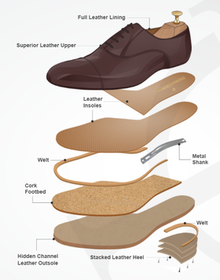| This article includes a list of general references, but it lacks sufficient corresponding inline citations. Please help to improve this article by introducing more precise citations. (August 2019) (Learn how and when to remove this message) |

A Goodyear welt is a strip of leather, rubber, or plastic that runs along the perimeter of a shoe outsole. The basic principle behind the Goodyear welt machine was invented in 1862 by August Destouy, who designed a machine with a curved needle to stitch turned shoes. The machine was then improved in 1869 and later by Destouy and, more importantly, Daniel Mills, an English mechanic, both employed by Charles Goodyear Jr., the son of Charles Goodyear. It has been noted by historians that Goodyear was a frequent visitor to the shoe factory of William J. Dudley, founder of Johnston & Murphy, where early work on sole stitching equipment was performed.
Construction
"Goodyear construction" involves stitching a welt to the upper and insole of a shoe. The welt is connected to both the upper and insole with thread by means of a raised ridge around the bottom outside edge of the insole, usually reinforced with a canvas-like "rib" (known as "gemming") which is cemented to the back of the ridge. The space enclosed by the welt is then filled with cork or some other filler material such as foam (usually either porous or perforated) or strips of leather, and the outsole is then stitched to the welt.
Process
The Goodyear welt process is a machine-based alternative to the traditional hand-welted method (c. 1500) for the manufacture of footwear, allowing them to be resoled repeatedly.
The upper part of the shoe is shaped over the last and fastened on by sewing a leather, linen or synthetic strip (also known as the "welt") to the inner and upper sole. As well as using a welt, stitching holds the material firmly together.
The welt forms a cavity which is then filled with a cork material. The final part of the shoe is the sole, which is attached to the welt by some combination of stitching and a high strength adhesive like contact cement or hide glue. The result is highly valued for being relatively waterproof by minimizing water penetration into the insole and the relative ease of resoling as long as the upper remains viable. Welted shoes are more expensive to manufacture than those mass-produced by automated machinery with molded soles.
References
- Understanding Shoe Construction: Goodyear Welt, Blake Stitch, & Cementing // Primer Magazine
- ^ Liu, Tessie P. (1994). The Weaver's Knot: The Contradictions of Class Struggle and Family Solidarity in Western France, 1750-1914. Cornell University Press. p. 174. ISBN 978-0-8014-8019-5.
- ^ Thomson, Ross (2018-08-25). The Path to Mechanized Shoe Production in the United States. UNC Press Books. p. 184. ISBN 978-1-4696-4423-3.
- Allen, F. J. (1916). The Shoe Industry. Рипол Классик. p. 124. ISBN 978-5-87444-797-7.
- US34413A, "Improvement in sewing-machines", issued 1862-02-18
- John Fluevog Shoe Production: The Goodyear Welt October 27, 2014
- US96944A, "Improvement in sewing-machines for boots and shoes", issued 1869-11-16
- Myers, William Starr (2000). Prominent Families of New Jersey - Volume 1. Clearfield Publishing. p. 517. ISBN 9780806350363.
- "Craft Of Goodyear Welt". Hartt.
- "Goodyear Welt Construction". Thomas George Collection.
Further reading
- R.A. Salaman, The Dictionary of Leather-Working Tools c. 1700-1950, Allen & Unwin, London 1986. pp. 182
- J.H. Thornton, Northampton College of Technology, Textbook of Footwear Manufacture, pps. 28-32, National Trade Press, UK 1953
- F.Y. Golding, edited by, Boots and Shoes, Vol. VI, pp. 178 The New Era Publishing, London 1936
- Thomson, Ross (1989). The Path to Mechanized Shoe Production in the United States. University of North Carolina Press. ISBN 978-0807818671.
External links
- Video: How Goodyear Welted Shoes are made USA ca. 1930
- pdf Document: The manufacture of boots and shoes : being a modern treatise of all the processes of making and manufacturing footgear (1902)
- pdf Document: Original Goodyear Welt Patent 1869
- 3D Animation Goodyear Welted Patent